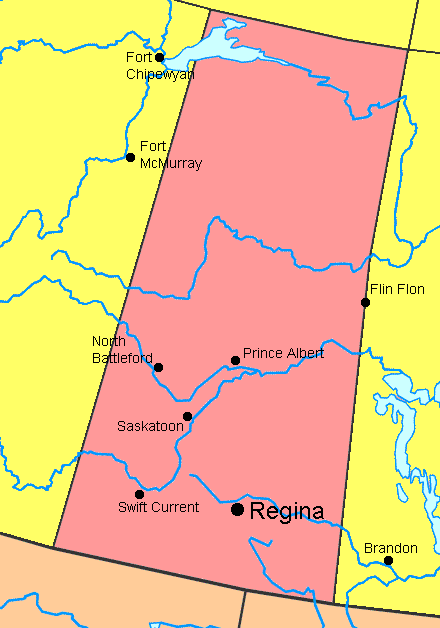|
Saskatchewan
Saskatchewan is a Canadian prairie province. It has an area of 651,900 km² (251,700 mi²) and a population of 978,934 (Saskatchewanians) (January 1, 2005). Most of its population lives in the southern part of the province. The largest city is Saskatoon with a population of 225,927 (January 1, 2005), followed by the province's capital, Regina (population: 192,800, January 1, 2005). Other major cities (in order of size) include Prince Albert, Moose Jaw, Yorkton, Swift Current, and North Battleford. Saskatchewan is (approximately) a quadrilateral bounded on the west by Alberta, on the north by the Northwest Territories, on the east by Manitoba, and on the south by the American states of Montana and North Dakota. The province's name, pronounced "sus-KATCH-uh-wun" by its inhabitants, comes from the Saskatchewan River, whose name comes from its Cree designation: kisiskāciwani-sīpiy , meaning "swift flowing river". Prior to European settlement, Saskatchewan was settled by Athabaskan, Algonquian, and Sioux tribes. The first European to enter Saskatchewan was Henry Kelsey in 1690, who travelled up the Saskatchewan River in hopes of trading fur with the province's indigenous peoples. The first permanent European settlement was a Hudson's Bay Company post at Cumberland House founded by Samuel Hearne in 1774. In the late 1850s and early 1860s, scientific expeditions led by John Palliser and Henry Youle Hind explored the prairie region of the province. In the 1870s settlement of the province started to take off as the Canadian Pacific Railway was built, and the Canadian government divided up the land by the Dominion Land Survey and gave free land to any willing settlers. The North West Mounted Police set up several posts and forts across Saskatchewan including Fort Walsh in the Cypress Hills, and Wood Mountain Post in south central Saskatchewan near the American border. The indigenous peoples were forced onto their own reservations, and the Métis people who had settled there, led by Louis Riel, attempted the North-West Rebellion to form their own government independent from Canada. Riel surrendered after two months and was convicted of treason in a Regina courtroom. He was subsequently hanged. As more settlers came to Saskatchewan on the railway, its population grew and it became a full province in 1905. |
|||||||||
